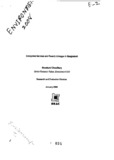| dc.description.abstract | What is the relationship between ecosystem services and poverty alleviation? Finding answers to
this question is vital if resources are to be used sustainably and to alleviate poverty. However, this
is a question that has not received thorough attention in Bangladesh. In an attempt to understand
and create linkages between ecosystem services and poverty alleviation, this Situation Analysis
(SA) presents and analyses literature that has been published in academic books and journals that
could help address this question.
In order to conceptualise the linkage between ecosystem services and poverty alleviation,
emphasis has been placed on identifying ecosystems services. These services primarily include
provisioning and regulating services. Additionally, it has also been important to identify the drivers
of change that alter services. Drivers identified fall into two categories: direct and natural, and
indirect and social. Keeping services and drivers in mind, the SA attempts to analyse various
drivers change services that could affect poverty, which in the SA is defined through the concept of
'well-being'. This includes security, basic material for a good life, health, good social relations, and
freedom of choice and action to influence decisions about services and well-being. Five different ecosystems have been chosen to demonstrate the linkages between services,
drivers, and poverty. In the mangrove swamp ecosystem section, focus is placed primarily on the
impact of shrimp farming regulating and provisioning services, as well as women's economic well-being.
Although women gain financially from shrimp fry collection, such activities have increased
salinity and have affected agricultural land. The impact of drivers such as, floods and riverbank
erosion, are explored in relation to inland water and floodplain ecosystem. Not only do these
drivers destroy homes and livelihoods, but they also greatly affect human health. In an effort to
control these drivers, the creation of embankments has had both negative and positive impacts,
which are discussed. The SA also covers two types of wetland ecosystems, haor and beel. Such
wetland areas provide vital provisioning and regulating services. These services are, however,
under threat due to poor policies and over exploitation of natural resources. When analysing agroecosystems,
the primary focus is placed on costs and opportunities that high yielding variety (HYV)
crops bring. Case studies on HYV demonstrate the paradox of the need for Green Revolution technologies to feed large numbers of people, yet at the same time how people must cope with soil
and water degradation due to heavy use of chemical fertilizers and pesticides. Finally, an analysis
of upland and lowland forest ecosystems highlight tensions between various actors and how poor
policies have drastically changed ecosystems and the ability of ethnic minorities to access
services.
The SA ends by identifying future areas of research taking account of the type of literature that has
not been found through a bibliometric approach. It is anticipated that attempts will be made to fill in
research gaps to create sound policies that both conserve services and help alleviate poverty. | en_US |

